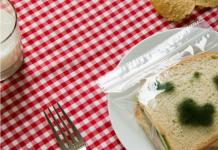Wood and its products are an excellent material for making doors. Its significant disadvantage is its susceptibility to moisture. As a result, the door may warp and shrink. As a result, the door frame does not fit tightly to the opening - gaps form, and cracks appear in the door leaf. Therefore, the question of how to insulate a wooden entrance door with your own hands is of practical importance. Methods of insulating a door come down to combating cracks and gaps through which drafts penetrate and heat escapes.
An effective way to increase the thermal insulation of a door structure can be:
Installing a second door will help save heat
- insulation using sealing profiles;
- sealing doors with rollers;
- insulation of the fabric with upholstery insulation;
- installation of insulation.
An additional method of insulation wooden door in a private house - installing a second door at the entrance to the house. For inexpensive doors, this is a profitable alternative to using polyurethane foam, isolon, or wood fiber.
The greater the temperature difference between the outside and inside the door, the higher the heat loss. The space between the doors - the vestibule - is constantly filled with heated air, so when installing additional door at the inlet, heat loss is minimal.
This method is not always suitable for apartment owners and will not eliminate drafts. To prevent cold air from entering the room, at least one door must also be insulated.
Mineral wool, corrugated cardboard, polystyrene foam, foam rubber, polyurethane, and wood fiber can be used as insulation.
Insulation using sealing profiles and insulation materials
Seals effectively eliminate gaps between the frame and the doorway. As a result of the use of wooden structures under the influence of humidity, the volume of the door can decrease by 10%. This applies to wooden doors of a prefabricated design. For example, paneled doors can also warp. That's why great way insulate a paneled door - provide a double sealing circuit: a rubber profile and special seals.
Rubber and foam rubber are usually used as a seal. Foam rubber lightweight material possessing also good warmth insulating properties. Convenient for work operations, protects the home from the penetration of cold air and prevents heat transfer. However, its use is not recommended. It is highly flammable and during combustion produces a toxic poison that is dangerous to human health. To avoid dangerous situations It is advisable to opt for a rubber seal.

Insulation using sealing profiles involves gluing a rubber seal around the perimeter of the door frame. To completely eliminate drafts, the door leaf must fit tightly to the door frame. To do this, you need to choose the right thickness of the seal.
The thickness of the seal depends on the size of the gap between the frame and the door leaf. Measurements are taken in compressed form. The length is equal to the length of the door perimeter. And the width is selected according to the width of the area of their contact.
If the seal material is selected and all necessary measurements completed, you can begin insulation. To do this, moving around the perimeter of the box using paper from the adhesive part of the seal
The work itself is very simple. It is necessary to gradually separate the paper from the adhesive part of the seal, moving along the perimeter of the door frame. The seal is secured by simply pressing your hand.
You might be wondering how to insulate front door to a bathhouse or steam room? .
Sealing doors with rollers
Allows you to get rid of drafts and reduce heat loss in your home without additional work.
A roller is a strip of leather or dermantine small size, inside of which there is a seal. You will have to make the roller yourself. The service life of the roller will depend on how correctly you chose the material and insulation, the installation location and installed it.
Manufacturing and installation rules:

- The material of the roller must match the material of the door upholstery;
- The width of the strip should be twice as long as the width of the door frame.
- how more durable material insulation, the longer the roller will last.
Wool and felt are susceptible to moisture, which can cause cavities to form inside the roller. As a result, such sealing is of little use, and the roller itself wears out quickly. Batting can be recommended as a roller filler and insulation material. Its structure is more uniform.
- In order to ensure effective protection to prevent heat loss, the roller should extend beyond the edge of the canvas.
- Accuracy. The rollers should be evenly spaced around the entire perimeter of the door leaf and secured with nails. Chaotic fastening and uneven edges lead to the fact that the rollers quickly become unusable.
The procedure for manufacturing and installing the roller:
- We cut out strips of the intended length from the material.
- We roll up the material and place the selected seal inside it.
- We twist the strip.
- We nail the resulting roller to the edge of the canvas so that the loose ends of the bundle are placed inward.
- Next, mark the installation location for the next roller and repeat the operation.
Upon completion of the work, we obtain hermetic insulation, which effectively protects against drafts and prevents heat transfer.
Foam insulation

The traditional way to insulate a door is to lay insulation. To insulate inexpensive Chinese doors, cheap materials are used: foam rubber, corrugated corrugated board, mineral wool, polystyrene foam. The most popular insulation material is polystyrene foam.
Advantages of polystyrene foam:
- Has a homogeneous structure. Unlike the use of mineral wool, there are no internal cavities in it, which provides effective protection against cold air flows.
- Has excellent thermal insulation properties. The thermal conductivity of polystyrene foam is comparable to isoprolol, and the cost is 6-8 times lower.
- It is not susceptible to moisture and is able to retain its properties after prolonged exposure.
- Durability of use.
Results
To achieve optimal results, foam insulation is carried out from the inside and outside outside doors. A synergistic effect is achieved by combining and simultaneous use of several insulation methods. This will keep your home warm and cozy.
How to insulate the front door in an apartment? The question today is very relevant and topical, because, despite the efforts of manufacturers, the creation comfortable conditions in the apartment is largely due to how skillfully and correctly the insulation of the front door was carried out after its installation, when all the shortcomings became visible. And as practice shows, insulating the front door is almost always the simplest and most unpretentious methods and technologies that allow you to get the maximum result with a penny investment. The positive effect in this case is not only an increase in the temperature in the apartment by 1-2 degrees, but also the elimination of unpleasant noise and dust penetration into the room.
Ways to insulate the front door
When considering methods of insulating entrance doors to an apartment, you should pay attention to the specifics of the work depending on the location of the door, the material used to make the leaf and door frame, and the method of installing this element in the building structure. This classification will allow us to determine the most acceptable and rational method of insulation.
There are several types of work on insulating entrance doors:
- Insulation of the door leaf;
- Installation of door seals;
- Installation additional elements metal entrance door;
- Insulation of the door frame and part of the walls adjacent to the entrance door.
In addition, it should be understood that the work of insulating and decorating the layer is warm insulating material will differ significantly for a metal and wooden entrance door. For metal doors, the number and variety of insulation technologies and materials is much wider, because the design itself allows the use of more powerful fittings - hinges, locks and the possibility of attaching to metal, as opposed to wood, where the choice is limited.
How can you insulate a door in an apartment?
To insulate the door leaf, standard materials are used, the only difference being that they should be of small thickness compared to those used for thermal insulation of walls. On the other hand, and this is true for apartments located on the lower floors, it is possible to choose full-size insulation to achieve better protection of the premises from the cold.
The main criteria that are put forward for the quality of insulation:
- Safety;
- Environmental friendliness;
- Simplicity and ease of installation;
- Thermal insulation properties.
The most popular thermal insulation materials:
- Foam;
- Polystyrene;
- Mineral wool;
- Foam rubber.
Of course, you can use cotton wool or batting as insulation, as was done in the 70-80s, but today no one will insulate the front door of an apartment with an old blanket or batting from a coat, and such a layer of insulation is of little use. Batting, like a sponge, absorbs moisture and over time will simply turn into dust, but artificial felt and others nonwovens may well be used as an internal filler for metal doors.
When insulating doors it is necessary outer covering burying the insulation layer. Most often, artificial leather, linings made of natural wood or MDF panels.
And of course, to install all these elements, you need fasteners - nails (regular and decorative), glue, self-tapping screws, plastic fixing plugs, in general, everything that is necessary for installation and reliable fastening of the insulation to the door leaf.
But this concerns the door leaf, but to eliminate drafts and seal the space between the door and the door frame, the following are used:
- Felt;
- Foam rubber seal;
- Rubber tubular seal;
- Foam rubber.
And, of course, you need to mandatory remember the gaps between the walls and the door frame, this is especially true in panel houses, where you cannot do without polyurethane foam, putty and filler, which is used as polystyrene foam.
Insulation of a metal door
Many people wonder how to insulate a metal entrance door in an apartment, because often it is not able to provide reliable thermal insulation. For such a situation, the most suitable option is external and internal insulation door leaf using foam rubber.
The insulation technology is carried out as follows:
- Removed door hardware– handles, locks, eyes;
- Using glue, a layer of foam rubber 1 cm thick is glued to the surface of the front door;
- The foam rubber is adjusted to the size of the door with the necessary allowances;
- The surface is again treated with glue, the outer decorative layer of artificial leather is glued or an MDF panel overlay is installed;
- The necessary accessories are installed.
For a metal door that can be disassembled independently, and these are mainly structures domestic producers, the best option installation of internal insulation is recommended. In the cavity between the stiffeners, a custom-sized insulation made of mineral wool or polystyrene foam is installed.
Attention! It is not recommended to use glass wool as insulation. Despite all its qualities and characteristics, glass wool deteriorates over time, and crushed glass particles can enter the lungs, which can have dangerous consequences.
The insulation is fixed with glue or double sided tape. The polystyrene foam, in addition, can be fixed with polyurethane foam, finally filling the cavities when installing the lining.
The decorative overlay is installed on a layer of felt or foam rubber. At the same time, carefully treating the areas where the material adheres to the metal base.
How to insulate a wooden entrance door
A wooden entrance door is most often insulated by installing felt or foam rubber, followed by installation of a decorative covering. Felt (in 1-2 layers) is attached to the door leaf with nails. You can do this yourself, without outside help. Felt is nailed every 10-12 cm around the perimeter of the door, and in the middle. To ensure reliable fastening, it is recommended to use glue; however, if the felt or foam rubber is 1-1.5 cm thick, you can glue it in such a way as to follow the contours of the paneled inserts.
A thin layer of foam rubber is glued on top of the main insulation on the wooden entrance door so that when installing the decorative layer, a more interesting texture can be created. Faux leather is attached using decorative nails, nailing the material both around the perimeter and with a corresponding ornament in the middle of the door leaf.
It is recommended to insulate the entrance door from the inside by installing thin slats around the perimeter. Glue thin foam plastic onto the resulting plane; this is the most suitable material. You can also cover the foam with an MDF cover.
Eliminating drafts
The simplest and easiest way to insulate a door to an apartment is to install door seal. A seal is installed around the perimeter of the door structure using glue. Installation is carried out on the door frame after the insulation has been glued to the door leaf. It is advisable to perform this operation 1-2 weeks after the main work has been carried out.
Advice: Before insulating the doors, you need to carry out work to eliminate cracks and cavities between the door frame and the walls. This will make it possible not to damage the doors.
The proposed methods and options for insulating entrance doors to an apartment are not exhaustive. Each door has its own individuality, and craftsmen can use their own, no less interesting and effective technologies.
There are a number of rules by which input and interior doors. When installing them in accordance with GOST, there are many options for how to seal the gap, which must be present. The gap ensures unhindered opening and closing of the canvas, even if it swells or is slightly distorted.
Clearance standards for a standard door
Rules for installing a door with a gap
The ease of use of the door structure depends on whether the gaps are formed correctly and the door is installed. If there is an increase in humidity, a wooden door will likely expand, which will make it difficult to open and close.
Pay attention! Too large a gap, especially when it comes to the front door, does not guarantee a secureherlocking in the closed position.
There are clear standards according to which the gaps between the frame and the door leaf should be formed. Moreover, everything depends on the size of the door, that is, the height, width and weight of the door are taken into account. In this case, some errors are allowed, for example, if in terms of dimensions the distance between the jamb and the canvas should be 5 mm, then 4-6 mm is considered the norm.
Standard door kit
If there is a standard door set with dimensions of 200x60x90 cm, then the gap on all sides should be 3-4mm. It is allowed to form a lumen of up to 5 mm if:
- indoors high humidity and ventilation is needed;
- the doors are made of a material that absorbs moisture very well.
It is worth paying attention to the distance from the threshold to the canvas. Under normal conditions, it is 2-2.5 cm. If you need to ensure improved ventilation and unhindered opening, the distance can be increased to 4 cm.
 Door seal
Door seal Rules for forming gaps
In order to avoid the problem of closing too large or developing small gaps, the door must initially be installed correctly. To do this, you need to wait a few simple rules during installation:
- When installing the box, you need to leave 1-2 cm for the initial gaps, because during the hardening process the foam swells and puts pressure on the box. During this process, it is impossible to create the correct gaps.
- When the foam has already dried and completely hardened, you can begin to form the gaps. To do this, you need to place a material of the required thickness on the sides and top between the canvas and the box. In case standard size boxes and canvases are 3-4 mm. The best thing in this case is the packaging cardboard from under the door kit. It is just that thick.
- To prevent the box from moving in the opening, it should be wedged.
- Check door balancing. You can use a building level for this. Despite its weight, the canvas should “sit” firmly on the wedges. At the same time load-bearing structure when open, it should not move.
As a result, after removing the wedges and spacers, the door structure should maintain an even geometry, and the gaps should remain in the dimensions that were planned when they were formed.
 An option on how to remove a draft
An option on how to remove a draft The gap is wrong, what should I do?
Situations where the gap is very small or large are common. In the first case, it is necessary to reduce the door leaf, in the second - insulation (closing) of the gap.
The first step is to check whether the box is warped; to do this, use a building level. Must be observed:
- Diagonals - the distance between opposite corners is equal.
- Angles - all should be 90 degrees.
If the gap is too small, you can carry out the following manipulations:
- Remove paint, especially on painted wooden doors that are many years old. Layering paint over time greatly reduces the gap.
- If there is no paint, then use a hand plane to trim the contours until a normal gap is formed.
If the gaps are very large (for a standard sheet - more than 6 mm), steps are needed to insulate and close the gap. This is especially important if the door is an entrance door, because having too much distance between the frame and the door leaf leads to:
- Deterioration of protective qualities. Such a door can be easier to break into, and therefore enter the room.
- The cold creeps in during the winter months.
- Sound permeability improves, which does not contribute to comfort.
Pay attention! If the door set (frame and leaf) have certificates, in accordance with state standards, there should be no problems with gaps for the front door. The question of how to seal the gap will not arise.
 Multi-chamber sealing tape
Multi-chamber sealing tape We insulate the gap
There are many options for how to close the gap between the door and the frame. Before insulating the canvas, you need to decide how much to reduce the gap.
Through the cracks, which are mandatory, it often blows, they do not provide sound insulation. In addition, the seal eliminates door slamming. When choosing a sealing material, it is worth starting not so much from aesthetics and ease of installation, but from insulating qualities.
Materials for sealing cracks:
- Sealing (heat insulating) strip.
- Silicone mass.
- Other options.
Each method is used depending on where the door is installed and the size of the gap.
Sealing tapes (self-adhesive)
The bands can be rubber or plastic. Regardless of the material, they are inexpensive and easy to install. It is easiest to work with self-adhesive strips. On one side they have an adhesive layer, which, provided the surface for gluing is prepared, adheres tightly.
 Double sealing “self-adhesive”
Double sealing “self-adhesive” There are tapes of different thickness and width. They can close gaps different sizes. Their only drawback is that they need to be replaced over time, especially if the door is constantly closed. In this case, the tape is compressed and reduced in size - this impairs its functionality.
- Clean the installation site from dust and degrease.
- Measure the required length of the tape, cut it with a small margin (up to 1 cm).
- Separate the protective film by 5-10 cm.
- Apply the tape to the door frame, it is best to start from the top from the corner.
- As you gluing, remove the protective paper.
- Press the tape tightly during installation.
In places where hinges are mounted, it is necessary to glue it to the front surface of the stopper or to the inner surface of the canvas. In the corners, the joints of the tape should be clearly trimmed.
Strips without self-adhesive
Their qualities are the same as the first type, the only thing they do not have is a self-adhesive layer. This makes them somewhat cheaper, and these options also have a different installation method.
Tape installation sequence:
- Clean the door frame from dust.
- Measure the required length of the tape.
- Close the door, in this position, place the tape on the jamb so that it fits tightly to it, even resting against the door.
- Nail to the jamb using short nails.
Thus, the door frame is completely upholstered. The distance between nails is no more than 10 cm.
 Insulation without self-adhesive
Insulation without self-adhesive Silicone paste
Or simpler - construction silicone. It is sold in small tubes, transparent or white. To apply the composition you need a special gun, which can be found in hardware store. The process of how to seal cracks with silicone:
- To prevent contamination of the door surface, you must first coat the areas where work will not be carried out with Vaseline.
- Insert the tube into the gun.
- Trim the tip so that the thickness of the silicone strip when extruded is slightly greater than needed to seal the gap.
- The gun should be held at a 45 degree angle to the jamb.
- Gently pressing the gun lever will begin to push the silicone out of the tube.
- The movement of the gun should be smooth so as not to squeeze out excess.
- After completing the treatment of all surfaces, close the door and wait until the silicone dries. The specific drying time is indicated on the tube with the material.
- After the time has passed, open the door and remove excess silicone.
Sealing joints in this way is convenient, because the silicone will take the shape it needs.
Other methods
Among them:
- Stuffing wooden glazing beads (thin slats) in places where there are cracks.
- Stuffing strips of felt or other dense fabric.
- The threshold can be insulated by stuffing a strip of soft rubber, special silicone curtains or “brushes” along the bottom edge of the door leaf. The latter option will not only provide thermal insulation, but also maintain ventilation in the room.
Conclusion
Methods for insulating and closing gaps between the frame and the door leaf depend on the size of the gap, financial capabilities and type of door material. You can implement any insulation with your own hands, without much physical effort.
Comments
Ksenia 09/10/2017 11:10
Grade
New articles
New comments
S.A.Grade
SvetlanaGrade
SergeyGrade
SergeyGrade
AlexeyEntering a house or apartment is not only secure door, but also the opening that is formed due to the thickness external wall. Modern door blocks are distinguished by good heat and sound insulation properties, so when installing them, all that remains is to finish and insulate the door slopes from the inside.
Aesthetic appearance and high-quality insulation entrance to the house, completes the overall interior of the room and serves as an obstacle to the penetration of cold air.
The exterior decoration of the doorway is usually carried out in a complex installation work for installing the front door. The gap between the wall and the door frame is filled with foam and covered with platbands, which are included in the installation kit. Indoors, you can seal seams, finish and insulate slopes yourself. 
According to the method of carrying out the work, there are three options for finishing and insulation:
- Applying cement mortar or putty mixture directly to the walls;
- Gluing finishing elements using glue or mortar;
- Frame fastening of finishing elements.
The material for insulation is selected depending on the type of door leaf and wall covering inside the room. The more finishing layers, the better insulation doorway. Used as a top layer: paint, wallpaper, decorative plaster, plastic, wood, laminate, MDF, PVC sandwich panels.
 If the width of the hole allows, then a layer of isolon or mineral wool is laid between the finishing layer and the wall surface. Otherwise, it is enough to seal the installation seams and level the surface of the slopes with cement mortar.
If the width of the hole allows, then a layer of isolon or mineral wool is laid between the finishing layer and the wall surface. Otherwise, it is enough to seal the installation seams and level the surface of the slopes with cement mortar.
Preparing the surface for finishing work
First of all, it is necessary to examine the installation seams for leaks. For this open flame candles are carried around the perimeter of the door. Places where the flame deviates towards the room should be sealed especially carefully.
Before finishing work, the door is covered with a protective film. The polyurethane foam that protrudes beyond the edge of the door frame is carefully cut off with a stationery knife. 
The inner surface of the opening is cleaned of construction dust and impregnated with primer. Then a cement mortar is prepared from one part of M400 cement and four parts of sand; water must be added with constant stirring until a homogeneous plastic mass is formed.
Beacons are installed on slopes using a level. metal profiles which are fixed with plaster or alabaster. The edge of the opening is reinforced with a paint corner. After the composition under the beacons has hardened, cement mortar is applied to the installation joints and the surface of the wall. Level it with a wide spatula, the edges of which slide along the beacons. 
The next day, the slopes are successively covered with the main and finishing layers of putty. The prepared surface can be painted, covered with wallpaper or other materials (laminate, PVC sandwich panels, MDF).
Insulation of the entrance to the apartment with plasterboard
Gypsum is a natural, safe, convenient building material. Insulating door slopes from the inside with plasterboard allows you to reduce installation time and achieve an absolutely flat surface. It is first necessary to seal the installation joints with cement mortar. It is not necessary to completely level the surface.
 To perform finishing works necessary:
To perform finishing works necessary:
- Take measurements from surfaces and make paper patterns;
- Cut the drywall and adjust the dimensions at the mounting location;
- Clean the surface of the walls and apply a primer;
- Using a level, secure the panels with glue or foam;
- Strengthen the edges of the drywall with paint corners;
- Putty joints and corners;
- Apply finishing layer putties.
The fastening of plasterboard parts begins from the top of the opening, and the inner and outer edges of the panel can be secured with a decorative corner made of plastic or fiberboard. 
Frame finishing of the entrance opening from the inside
To securely fasten the elements of finishing material in the entrance door opening, use a frame made of metal profiles or wooden planks. The installation seams are sealed as described earlier. The slopes are primed and leveled with cement mortar, since the frame structure must fit tightly to the surface.
The main profiles are attached along the inner and outer perimeter of the opening. For the stability of the entire structure, jumpers are installed between them. Such jumpers in the upper corners of the frame facilitate the installation of finishing material. 
The frame mounting method allows you to use almost any finishing material for insulating door slopes from inside the room. If the frame is made of wooden planks, installation of laminate, parquet boards, MDF boards, wooden or plasterboard panels can be made with self-tapping screws.
When laying the laminate transversely, fastening begins from the bottom panel, which is fixed on both sides to the frame structure.
All subsequent elements are installed using lock connections. The top panel is also fixed to the frame with self-tapping screws.
edges frame structure are closing decorative corners in accordance with the selected finishing material.
Plastic lining of the entrance from inside the room
Plastic is not particularly durable, but its cost is an undeniable advantage over other materials. In addition, if you fasten the slats plastic siding horizontally, this will strengthen the structure of the slope lining. 
Sealing assembly seams produced as usual. The surfaces of the opening are cleaned and primed. Then the necessary measurements are taken and the siding slats are cut according to the patterns. The upper and lower lamellas are cut at an angle in accordance with the bevels of the walls.
Guide elements (J-profile) are installed on the upper and side sections of the internal door opening. Fixed along the outer perimeter corner profile or platband. Plastic slats are laid horizontally between the guide profiles.
If the width of the opening allows, before attaching the plastic siding, lathing is done and insulation is laid between the planks.
At frame method finishing can not only insulate the slopes, but also lay hidden electrical wiring and telecommunications, install built-in lighting that turns on when the door is opened.
Watch the video:
After completion of installation work protective coating The doors are removed from the surface and power is connected to sockets and lighting points. The entrance opening is ready for use.
One of weak points In a housing insulation system, a house can be called windows and entrance doors. Proper door insulation can reduce heat loss by 25-30%.
High-quality insulators for the entrance door, their choice is the key to success in the fight for energy saving.
Heat the door leaf to the block.
The main method of heat loss is a poor connection between the door leaf and the closing latch. In the created cracks, which neither the apartment owner sees, cold masses of outside air enter the rooms.
In general, this disease is common in wood products as a result of the lack of reliable seals. Since wood can change its geometric dimensions (shrinkage, swelling), it is simply necessary to use materials that provide a reliable seal to the neck door, depending on the indoor conditions. The cheapest is foam, I must say that this material cannot be called the optimal choice.
The foam itself is short, very sensitive to moisture, and is undesirable for use on intensively operated doors. Although it can be used for example on balcony door, provided that  in winter it rarely opens. More modern material profiles rubber seals based on self-adhesive materials.
in winter it rarely opens. More modern material profiles rubber seals based on self-adhesive materials.
It is more durable and reliable, suitable for front doors. When installing, consider the thickness of the seal; if too thick is used, problems with closing the door may occur.
Heating of wooden doors.
Practically the only way insulating wooden doors means covering it. In this case, cotton wool, foam, and insole are usually used as insulation.

Heating of metal doors.
The insulation of metal doors also varies. I would like to say the following: best option- buy metal doors, made to order, and you can determine all the nuances of door insulation.
How to insulate an iron door with your own hands - step-by-step thermal insulation training
Standard metal doors are usually supplied without internal insulation. Polystyrene foam, extruded or non-extruded, and mineral heaters are usually used as internal insulation materials.

The current selection of heaters can effectively solve the problem of excessive heat loss, and the key to success will be implementing manufacturers' recommendations for installation.
20. 3. 2013 at 15:03
 These problems can be cured if you properly insulate your front door. Used for insulation various materials, most often foams made from plastic and fiberboards:
These problems can be cured if you properly insulate your front door. Used for insulation various materials, most often foams made from plastic and fiberboards:
- fibrous materials are stone and mineral wool, which take the form of solid plates or a cylinder heater. They have good thermal insulation, acoustic insulation, they do not support combustion, they are easy to fix.
In this case, cotton wool has a significant disadvantage - when it is wet, volume is lost, and after that the insulating properties are significantly reduced.
Therefore, the use of this material will be recommended in apartment buildings with heated access doors;
- polystyrene - polymer material, in which the bubbles are filled with air.
Polystyrene has the same structure, but it is filled with nitrogen, but not air, so it is less susceptible to burning and breaking down.
Both products come in discs of varying thicknesses, allowing you to choose the one that suits you. Polystyrene foam and polystyrene are not afraid of moisture and are suitable for use in all rooms.
Also read: How to properly insulate an iron door with your own hands
What materials and tools are needed to insulate iron doors
 materials:
materials:
- a heater that suits your requirements;
- sheet of fibreboard, MDF or chipboard;
- seal;
- self-tapping screws;
- foam assembly;
- liquid nails.
tools:
- drilling;
- pencil;
- screwdriver;
- electric saw blade;
- roulette;
- sharp knife;
- screwdriver.
How to insulate a metal door from the inside
 Create warm home, comfort and get rid of the cold, you will help warm the door from the inside.
Create warm home, comfort and get rid of the cold, you will help warm the door from the inside.
First you must remove the door from its hinges. This work will be simpler and easier if the door is in a horizontal position.
Metal plates are usually secured with screws. Unscrew them and inspect the space inside. When measuring with a pencil and tape, remove and write down the measurements. It is necessary to prepare the heating of the material. Inside you will see pipe profiles that divide the space into cells. This design provides a durable entry door. The depth of the thermal insulation material is smooth. Access to doors and locks must remain free. To attach the heater, it is best to use liquid nails to ensure it is unbreakable, and the cracks between the pieces of material are covered with foam.
Then we'll finish.
How to insulate a wooden front door? Self-isolation modes
Covering expensive doors is often not made from one sheet particle board or fiberboard. It is advisable to replace the questionable material with a new sheet that you previously attached to the required dimensions.
The fiber is fixed with ordinary screws.
Continue with the final assembly phase. The metal sheet is returned to its place and secured with screws. Then carefully check the resulting door.
Any open cracks should be filled with sealing material.
Note. If you decide to insulate your metal doors, remember that it won't work.
It is necessary to cut off one front part of the canvas and replace it with a chipboard plate.
How to insulate iron gates from outside
 In the cold season, to prevent condensation and the front door from freezing, it is necessary to insulate the outside.
In the cold season, to prevent condensation and the front door from freezing, it is necessary to insulate the outside.
Insulation of external doors may be required in a private house and apartment.
This method requires a lot of effort and time because there are no cavities in this part for laying insulation.
First you need to make a special door frame.
Remove the door from its hinges and measure its pages. The frame is suitable for simple wooden planks. It is desirable that the material has a thickness of 20 mm and a width of 30 mm.
The wooden frame will move around the perimeter of the door. The strength of the structure is increased by transverse rails. Repair it with screws. Thus, create an internal cavity. We filled it with insulating material and attached it to liquid nails. All distances between parts of the insulation explode the foam. We are waiting for it to dry completely.
Continue from the end that will hide the insulating material. To do this, remove the sheet of fiberboard or MDF mounted on the dimensions of the door and repair it carefully.
Heat the door frame.
 The iron door is made from a corner attached to the wall with metal pins.
The iron door is made from a corner attached to the wall with metal pins.
There are often gaps between the wall and the frame that are foamed when they are provided with prefabricated foam. This has a main drawback - when exposed to light, the foam installation quickly loses its protective properties and falls. You can figure it out in brown or yellow color. If this happens to your box, you must remove the old foam and reseal the insulation.
To do this:
- wall that fits the neck cleans old insulation, opens the plaster on a hard layer, removes remaining dust;
- the surface is dispersed with water, after which slots and holes more than 2 cm deep are filled with foam for assembly;
- Wait until the foam is completely dry.
Excess cut with a sharp knife;
- neck finishing plaster. A properly insulated door frame keeps cold air out.
An iron door, thermally insulated by all rules, completely preserves warm air in the house and provides reliable protection from noise.
Frost approximation is increasingly important. And the door is one of the first among cold areas.
Through cracks in the canvas itself or a break with the box in the house (regardless of a private house or apartment), drafts, odors and noise penetrate from the outside.
Such sealing and thermal insulation outer door affects not only the room temperature, but also the overall atmosphere and comfort.
Replacing door units for newer, warmer ones is not for everyone. And in this article we will look at ways to insulate existing wooden doors with our own hands, video is attached.
Heating Methods
When deciding how and how to insulate wooden doors, for example, in a private house, there are several main directions.
All of them are directly related to the design and possible sources of the project:
- To generally improve the thermal insulation properties or the presence of cracks in the canvas, insulate the linen.
- If there are gaps between the door frame and the board, secure the joint.
- Damage to the neck box (frame) - heating.
Heating a wooden door frame
It might be worth starting by insulating the box itself.
Because no attempt to insulate wooden doors will be effective if there are large spaces between the wall and the frame.
Check if there are cracks in the frame and between the wall and the wall, if possible, eliminate the cause and close.
How to insulate wooden doors with your own hands using sealing joints (video)
Connection methods:
- Using sealant.
- Using cylinders to close the gap between the fabric and the box.
These heating methods for wooden doors are simple and easy to do.

Photo from the site: x-teplo.ru
Install the seal on the door frame
The seals have different mounting: self-adhesive or self-adhesive, with or without clip.
Profile: single, double, triple. Material: plastic, rubber, foam rubber, etc.
The easiest way to seal doors with sealing material is a self-adhesive rubber profile. It is glued along the edge of the frame, which increases the tightness of the substrate. It simply attaches, but ultimately the density of its adhesion is significantly weakened.
On a low budget, and if you have dermantine cuttings, you can warm up the entrance wooden door, more painted with dermatological tape.
It is attached to a box with small upholstery nails. This is not the most effective method, but it will also help you reduce the number of drafts.
The width of the sealant is selected from the cell size.
The thickness is taken according to the gap between them. The required length is calculated by measuring the circumference of the box.
Further measures depend on the selected seal.
When determining thickness, you can use ordinary clay. It is wrapped in cellophane, placed between the box and the fabric and closes the door. The resulting cylinder will be the required thickness.
In this video you will find an example of printed insulation:
Cylinder seal
Among the DIY thermal insulation methods for wooden doors, thermal insulation with rollers is one of the most common methods.
Just 15-20 years ago, every second entrance to the apartment was arranged in this way.
It's simple, inexpensive and convenient if there are no other ways to isolate it.
At the edge of the door frame, a suitable thermal insulator appeared in the cylinder within the gasket material.
This is an example of a roller seal:
Do-it-yourself thermal insulation of a wooden door leaf (video)
Wood is a substance that retains heat well.
Therefore, if there are small gaps (for example, on a balcony door), it is enough to paint the surface in time to reduce precipitation.
But for complete thermal insulation, it is better to insulate the doors with upholstery.

Photo from the site: semidelov.ru
The front door is an expensive but permanent welcome.
It is often used in parallel with all the others.
For upholstery you need:
Upholstery material.
Depending on your quality, use special fabric, vinyl, genuine leather or dermantine.
Heater. They can be foam rubber, synthetic rubber, various mineral wool, foam, insole, foam, polyurethane foam, etc.
Some materials require the use of a vapor barrier.
The depreciation process itself does not depend on the type of materials used, with the only exception in the form of foamed polystyrene.
An example of upholstery that you will find in the video:
Installation of double doors
This is another way to insulate your front door.
Yes, he needs expenses and “eats” a room in the corridor.
But the effectiveness of this method is one of the best.
The air between the two sheets will be further contained from escaping heat.
In addition to other doors, you can use all the same methods of additional insulation.
It is not difficult to install additional door blocks. When you don't need to improve apartment security, the right interior door fits with the threshold. Its installation is standard, the only thing required is to immediately close the connection between the frame and the fabric.

Photo from the site: www.rumas.ru
I hope the article helps you.
And all doors - entrance and balcony, wooden and metal, new or insulated with your own hands, will keep your home warm.
Don't forget to create a better microclimate in your home, which requires a systematic approach. Along with the door, you may have to handle windows or walls. And if this private house, then the roof and floor.
Even with thermal insulation, one element of individual reception is not enough.
Another example of using several methods of heating a wooden entrance door with your own hands is in this video:
Another option is to install double doors.
Rubber seals will last longer when pressure plates are installed.
Now almost all apartments have a metal entrance door, thanks to which you don’t have to worry about the safety of your home. But, unfortunately, this design has one significant drawback - it greatly lets in cold and sounds from the outside.
In order to enjoy peace and quiet in your apartment, as well as avoid heat loss in winter time, you can insulate the door yourself.
What is insulation and why is it needed?
Iron is good guide, even if the door closes tightly and hermetically, cold air from the street it immediately ends up in your apartment.

Therefore, the main tasks when performing insulation work are:
- strengthening the sealing of the door frame and the door itself;
- high-quality insulation of metal fittings and parts;
- placement of insulating material inside the door leaf.
In addition to the listed tasks, insulation work is also carried out to increase the service life of the door and to protect against mechanical damage.
Let's figure out how to insulate an iron entrance door.
Types of insulation. What is the best way to insulate?
The most popular materials for insulation are: cardboard, polystyrene foam, glass wool, polyurethane foam and foam rubber.
When insulating the front door with corrugated cardboard, the thermal insulation does not have a high level, but at the same time the door itself does not become heavier due to the small mass of the material.
Foam plastic is an easy-to-use, durable and environmentally friendly material, with high thermal insulation and noise reduction properties.
When purchasing a material, you need to pay attention, first of all, to its weight and structure and give preference to foam sheets with a dense structure.
This material is by far the most effective heat insulator.
 Polyurethane foam has similar properties and quality characteristics, but has a higher price.
Polyurethane foam has similar properties and quality characteristics, but has a higher price.
You can insulate the door yourself using glass wool (a type of mineral wool).
The material is made from sand, glass, lime, borax, dolomite and soda. Has high heat and soundproofing properties, good resistance to elevated temperatures, which allows glass wool to be classified as a universal insulation material.
However, glass wool is rarely used as insulation for steel door, due to low density, increased fragility and fragility of the fibers. Over time, glass wool absorbs moisture and becomes damp, which leads to the appearance of an unpleasant odor and streaks.
Another significant drawback is the settling of the material, which leads to the formation of voids in some parts of the door.
Polyurethane foam has very low thermal conductivity, does not absorb moisture and is very light in weight. It has a low degree of fire resistance, so it is not recommended to use it for insulating doors.
Foam rubber as insulation is the worst option. They can only be used to insulate wooden structures.
Therefore, if you are deciding how to insulate the front door, it is better to choose foam plastic as a material, which has good heat and sound insulation properties.
Rules for insulating a door frame
 Carrying out insulation works will not be completed until the door is completely insulated from noise and cold.
Carrying out insulation works will not be completed until the door is completely insulated from noise and cold.
When the walls are skewed, due to the destruction of the door frame over time, its deformation, a gap appears between the wall and the frame, due to which significant heat loss occurs in the room. Therefore, during installation, the box profile must be filled with a special solution.
If this has not been done, you need to drill holes in the box and fill the cavity with foam or use granular sealant.
How to insulate an iron door from the inside and outside
In solving this issue, much depends on the type of canvas, whether it is collapsible or not.
If the door leaf can be disassembled, the material is placed inside.
 In this case, the seal can be:
In this case, the seal can be:
- hard - polystyrene, polystyrene.
It is selected based on the thickness of the door leaf, and is placed in the middle of the door in a spacer, due to which it is held inside;
- soft - glass wool, in this case it is necessary to moisture-proof the material by covering it with film. Otherwise, it will absorb condensation, which will lead to corrosion of the material over time.
Before performing work, the locks and handles are removed and the box is disassembled.
Placed inside insulation material, the structure is assembled and installed in its original place.
How to insulate an iron entrance door in the case of a non-demountable structure?
 Only with the help of an additional lining inside the canvas. The door is removed from its hinges, all fittings are removed. A beam is screwed along the inner perimeter ( optimal diameter 10x10mm), the upholstery is stretched and secured with special nails on the slats.
Only with the help of an additional lining inside the canvas. The door is removed from its hinges, all fittings are removed. A beam is screwed along the inner perimeter ( optimal diameter 10x10mm), the upholstery is stretched and secured with special nails on the slats.
You can fill the cavity of the door block with a bulk heat-insulating composition.
However, this operation is possible only if there are no mechanisms inside the leaf to control the crossbars that close the door at the bottom and top. In such a situation, insulation is carried out only from the outside (provided the surface is flat). To do this, a roll of elastic insulation material is attached to the canvas. This type of insulation work does not look very aesthetically pleasing, so a wooden or plastic covering is placed on top.
How to insulate a Chinese door?
In practice this question occurs constantly with the onset of cold weather.
Unfortunately, to insulate the iron Chinese door It’s impossible to do it yourself; you can’t disassemble and reassemble it, because... this is not provided for in the production process.
If you were able to disassemble such a structure, you will no longer be able to assemble it; it practically falls apart. Therefore, such popular insulation methods as disassembly, filling with insulation, assembly, etc. in this case will not pass.
It is also not possible to insulate it from the inside by filling the voids with foam, because... the product is deformed, and the locking rods or lock may also jam.
This door is made of steel, but not strong. Attempts to veneer the outer surface will also lead to nothing good; even a small additional load will deform the product. Therefore, figure out how to insulate a door in a private house if it made in China quite difficult.
Cladding rules
 This type of work is carried out to improve appearance, enhancing heat and sound insulation.
This type of work is carried out to improve appearance, enhancing heat and sound insulation.
The most popular, although expensive, type of cladding is metal panels MDF.
The material is harmless to health and resistant to fungus. After completing such a lining, it must be covered with an anti-vandal film to protect it from mechanical damage.
The product can be covered with leatherette, clapboard, plywood.
Step-by-step technology for insulating an iron entrance door
How exactly to insulate is up to you, most often the choice depends on technical condition products, material capabilities, preferences and taste. The upholstery work is carried out after removing the door from its hinges, removing the handles, peephole, and lock. It is best to line the front door on both sides.
By insulating the door, you will get rid of problems in the form of extraneous noise and will be able to relax peacefully in your warm and cozy apartment.
Based on materials from the site http://www.mnkk.ru/
Proper insulation of a wooden entrance door provides excellent protection of the home from the cold and helps with sound insulation. Let's figure out how to do the job yourself.
Input door designs represent a shield that protects the house and its inhabitants from many external influences. Therefore, they must be reliable and durable, and in addition, have special characteristics that guarantee protection of the home from extraneous odors and noise, from frost and excessive heat.
Experts recommend insulating the front door of a house in the following cases:
- the appearance of the product has become unattractive;
- the old insulation was installed poorly or was worn out during the operation of the door;
- the structure was not initially insulated.
Wooden structure without insulation
The cost of purchasing them will be fully recouped by the comfort in your home.
And if you carry out all the activities yourself, you will have to spend a minimum of financial resources on updating the insulating layer.
Currently, insulation of wooden doors is carried out using the following materials:
- Foam plastic is ideal for thermal insulation of doors from the inside, characterized by low cost and quite attractive appearance.
- Foam rubber is an inexpensive porous material. It is very popular among residents of rural houses due to the ease of its installation. Foam rubber can easily be called the most budget-friendly type of insulation.
- Mineral wool – good material(guarantees high level thermal protection, it does not harbor rodents and insect pests), which, unfortunately, has several serious drawbacks. These include the ability to accumulate moisture and subsidence of mineral wool over time.
- Izolon is a foam type polyethylene, one of the types of ordinary foam rubber with more high performance thermal insulation of premises. Its cost is higher than that of ordinary foam rubber, but it also provides more durable and high-quality insulation.
- Polyurethane foam is perhaps the best insulating material today, which can be used both in a rural house and in a city apartment. Disadvantages - high cost and certain complexity of application to a wooden surface (processing is carried out by spraying, which requires certain skills).
- Expanded polystyrene is a material that extinguishes itself when a fire occurs. It contains air in large volumes, which determines the excellent thermal insulation characteristics of polystyrene foam.

Materials for door insulation
Insulation can be carried out with any of these materials, focusing on climatic conditions in a specific area and to your own financial budget.
Do-it-yourself thermal insulation measures will bring minimal effect without necessary preparation doors. It is necessary to carefully analyze its condition for wear and installation defects. Based on this inspection, perform the following actions:
- purchase accessories in advance if there is a need for replacement door peephole, locking mechanisms, handles and so on;
- replace the hinges or tighten their fastenings in cases where the doors do not close well, are distorted or sagging;
- trim the door leaf using a plane if adjusting the hinges did not lead to the expected result due to significant play in the structure.

Adjusting door hinges
It is also necessary to update the door seal when significant gaps have formed between the door block and the wall. If they are relatively small, it is recommended to carefully seal the cracks.
Then you can remove the old coating from the entrance wooden structure of the house, apply a good antiseptic composition to the canvas to increase the service life of the product, and proceed directly to insulation. With our tips, you can easily do this procedure yourself.
The first step is to cut out the insulating material you have chosen with your own hands. When thermally insulating a solid door leaf, it is necessary to cut off a piece that clearly coincides with geometric parameters entrance structure. If you are insulating a collapsible door, first of all, part of the material is cut out for its internal sections. Such sections are present on the canvas due to the fact that it has special stiffening ribs - internal crossbars made of wood.
After placement heat-insulating material the door needs to be upholstered with some kind of decorative material. In a rural house, leatherette is often used for these purposes - it is inexpensive and looks attractive material. You can also use more expensive products, for example, made from genuine leather.

Door upholstery with decorative material
The insulation itself is attached to the door leaf in various ways. When doing the work yourself, you can use:
- small upholstery nails;
- self-adhesive films;
- glue.
After installing the insulation, you will immediately feel the result of the work performed - the house will become much warmer even in severe frosts. At the same time, it is advisable to install seals that ensure a high-quality fit between the door frame and its wooden leaf.
This procedure is done simply. You will need to buy a sealant in the form of tape from a hardware store. It is usually made of rubber and equipped with a self-adhesive backing. Simply select a seal of the thickness you need (it is determined by the size of the gap between the frame and the leaf), clean the junction of the specified door elements from dirt and dust, and then mount (stick) the tape into the gap.
You have completed high-quality thermal insulation of wooden doors with your own hands. Enjoy the warmth in your home!


















